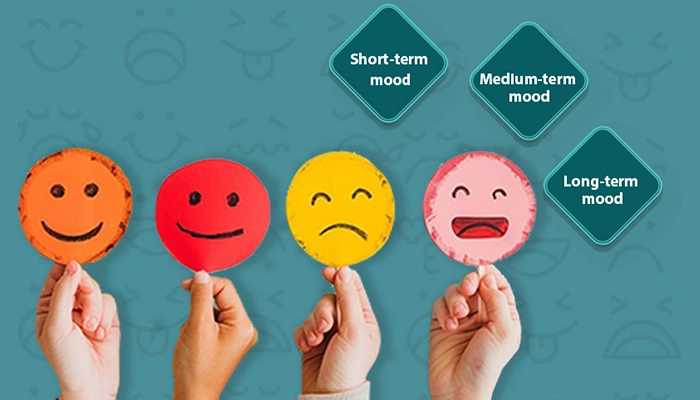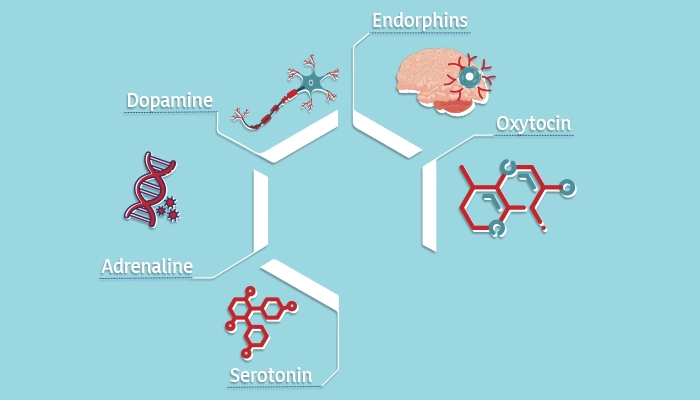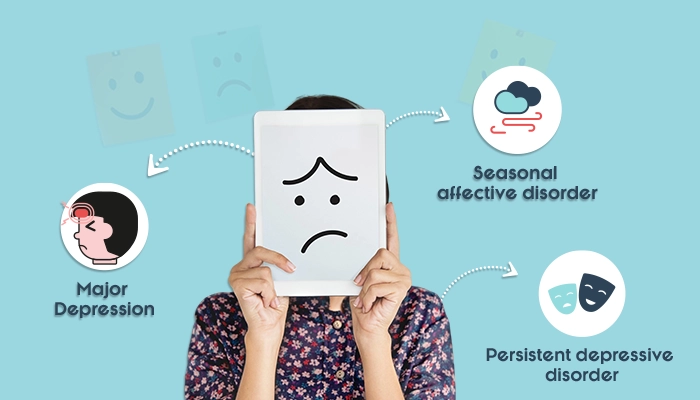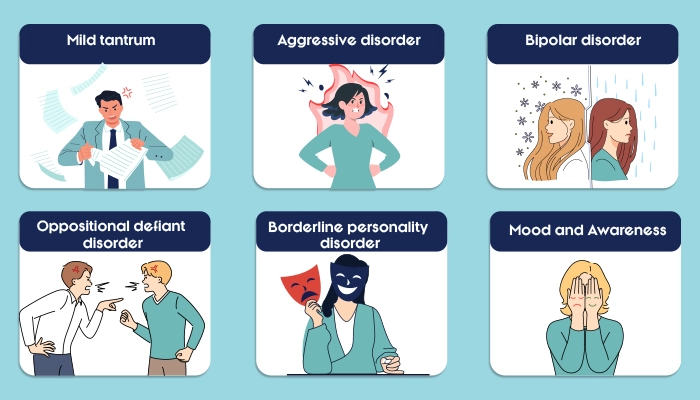“Moods are sustained and temporary emotional states and are categorized into two major types: positive and negative, which include happiness, excitement, sadness, and anger etc. Several studies have reported approximately 27 varied categories of emotions, which are mainly thought of as types of moods.”
Mood is a significant psychological state that has a strong influence on thoughts, emotions, as well as behavior. This is a complex aspect of emotions that determines how individuals perceive the real world around them. Moreover, mood is a specialized state of mind that is strongly linked to and responsible for the development of different kinds of emotions. Different internal as well as external factors can develop different kinds of moods.
Moods are such kinds of emotional states that may be short-term or persist for a longer period. They also exhibit diversity, including positive or negative moods, etc. At one time, the person can feel happy, while at the other time, he can feel sad, bored, etc. Likewise, some situations urge individuals to share their emotions, while some hide their moods and emotions. However, if you want to know more, then read this article. After reading this article, you will become familiar with different types of moods, their causes, and the ways to improve your mood.
What is Mood?
Moods are the person’s emotional condition that plays a significant role in maintaining well-being. They can alter the emotional landscapes that ultimately affect the functioning of life. Moreover, they are categorized based on different factors. Depending on the tone, the mood can be positive or negative. Likewise, their intensity also varies, whether strong or weak. In addition, each individual experiences different moods. So, individuals can experience a complex spectrum of emotions that affect their quality of life.
Furthermore, there are multiple differences between moods, feelings, thoughts, and emotions depending on the specificity and association with specific objects. Humans experience different types of basic moods, including happiness, sadness, anger, excitement, or feeling low.
Any kind of mood disturbance can lead to the development of psychiatric or mental health issues, which include anxiety, depression, bipolar disorder, ADHD, obsessive-compulsive disorder, mood disorders, personality disorders, adjustment disorders, etc.
Read More: How does Mood disorder affect daily life?
What is the Mood Like?
Mood is a physiological condition greatly influenced by several internal and external stimuli. However, external factors exhibit a major contribution. Two major types of moods have a strong environmental impact, including positive and negative moods. However, the most common types of mood are as follows:
| Animated | Caring |
| Angry | Dark |
| Calm | Carefree |
| Defensive | Cheerful |
| Friendly | Combative |
| Grateful | Heartbroken |
| Hostile | Impatient |
| Restless | Romantic |
| Silly | Tender |
| Strange | Unaffected |
| Uneasy | Wretched |
| Unstable | Vivacious |
| Wretched | Tense |
| Serious | Sentimental |
| Solemn | Thankful |
| Unaffected | Uneasy |
| Vivacious | Overwhelmed |
| Miserable | Idyllic |
1. Positive mood
You have experienced different scenarios that divert your mind to develop a positive mood. For example, you feel pleased, energetic, and satisfied if you wake up and find your loved ones around you or spend some time with your friends and family. You feel cheerful when you feel low energy, but you spend quality time with your friends.
The common types of positive moods are as follows:
| Type | Description |
|---|---|
| Happiness | This involves the feelings of pleasure, satisfaction, and contentment |
| Joy | A state of relaxation and extreme excitement during special occasions |
| Serenity | A state of calmness, tranquillity, and acceptance of reality |
| Love | A state of deep emotional attachment |
| Surprise | A sense of happiness and excitement from an unexpected event |
| Contentment | A state of peace and satisfaction |
| Gratitude | A sense of thankfulness |
| Pride | A sense of satisfaction from self-achievement |
| Curiosity | Desire to explore more things |
| Confidence | strong sense of belief in abilities |
| Enjoyment | A sense of pleasure in different experiences or activities |
| Thrill | Pleasure in exciting experiences |
2. Negative mood
Suppose you hear any sad news or experience an accident. In that case, there is a greater probability that you will feel low, frustrated, sad, and hopeless, which are the symptoms of a negative mood. Likewise, other types of negative moods include:
| Type | Description |
|---|---|
| Anger | A sense of displeasure |
| Guilt | State of wrongdoing |
| Frustration | Strong feelings of anger |
| Fear | Feelings of threat or panic |
| Hopelessness | A sense of worthlessness and a strong feeling of doing nothing |
| Contentment | A state of peace and satisfaction |
| Gratitude | A sense of thankfulness |
| Self-doubt | Lack of confidence |
| Anxiety | Desire to explore more things |
| Irritation | Sense of anger |
| Disgust | Strong feelings of awkwardness |
| Jealousy | Negative emotional response to valued relations and possessions |
| Shame | Feelings of worthlessness due to failures or shortcomings |
| Disappointment | Sadness due to losing expectations |
| Confusion | Lack of clarity in thoughts, emotions, and concepts |
| Indifference | Reduced concern or interest |
| Pessimism | Seeing the worst aspects of things |
What are the different types of Moods?
There are different types of moods, but among them, the most common ones are as follows:
1. Active and passive moods
If you have an active mood, then you will feel extremely high levels of energy. You will also consider yourself capable of achieving all your life goals. However, the passive mood is the state when you feel extremely low energy levels and think that you are useless. Moreover, you also feel fatigued, tired, lethargic, and bored. You do not feel any kind of contentment in your life, and your mind remains stuck in persistent, anxious thoughts.
2. High Approach vs Low Approach moods
Individuals with a high approach do not feel hesitation in their interaction with others. They always prefer to engage themselves in different social communities.

Types of mood based on the intensity
Another major factor that differentiates between the types of moods is intensity. Each type of mood is different from the others, which are as follows:
- Weak
- Strong
- Medium
- Extreme
Based on these levels of mood, there are the following types of mood:
1. Weak mood/Low mood
Individuals with this type of mood experience reduced emotional changes. Moreover, the weak mood is also not considered and, in most cases, remains unnoticed.
2. Average/Medium mood
This involves the average state of emotional fluctuations. As compared to the weak mood, emotions and feelings are also considered and noticed. Moreover, they also have a certain impact on different aspects of an individual’s life.
Strong moods: This type of mood comprises extreme emotions and feelings, and individuals also face difficulty in regulating them.
Types of Moods based on the duration and stability
Other than the intensity, there is a variation in mood based on the stability and duration, such as:
1. Short-term mood
As the name indicates, this type of mood only lasts for a shorter period. In addition, the short-term mood is more susceptible to environmental changes.
2. Medium-term mood
This type of mood is more stable than a short-term mood. Moreover, this stays for multiple days or weeks.
3. Long-term mood
This persists for several months and years and also exhibits resistance towards external factors.
What Do Your All Types of Moods Depend On?
Multiple factors can regulate the moods. However, among all of these, the role of hormones is quite considerable. The following hormones play a significant role in controlling moods such as:
1. Dopamine
The dopamine hormone can improve mood. Moreover, it elevates the rate of confidence and self-esteem.
2. Adrenaline
This hormone prepares the body to deal with any emergency.
3. Serotonin
If serotonin is released in a controlled amount, then it lifts the mood and results in the sensation of well-being.
4. Endorphins
Endorphins are mainly involved in elevating energy levels. Moreover, it also develops a sense of optimism.
5. Oxytocin
This hormone plays a role in generating feelings of pleasure or relaxation.

What are the Mood swings?
Mood swings are the sudden or unexpected changes in the emotional state of individuals. There are different trigger factors of mood swings, which include genetic, hormonal imbalances, as well as external stress factors. Among all the factors, chemical imbalances are considered one of the major reasons for mood swings.
Some people experience more mood swings, while some are less prone to emotional fluctuations, and these only happen after a long time.
Different studies have reported that those individuals who are more prone to mood swings are more likely to suffer from common mental health issues, including anxiety, depression, obsessive-compulsive disorder, schizophrenia, post-traumatic stress disorder, as well as borderline personality disorder etc.
Read More: How can I deal with regular Mood swings & Mood disorders?
What is a Good Mood Type?
The good mood type indicates the existence of a positive emotional state. If you are in a good mood, then you can feel joy, happiness, gratitude, and optimism. Moreover, individuals also have satisfaction in their lives and think they have all the capabilities required to live a happy life. In addition, individuals show extremely positive behavior, which in turn also promotes their relationship with others. The presence of a good mood type is highly significant in living a happier and prosperous life.
Mood vs Affect
There are some visible differences between mood and affect, which are as follows:
| Mood | Affect |
|---|---|
| It results from multiple experiences | It results from the most recent environmental factors |
| It is less influenced by the external factors | It is greatly influenced by the environmental factors |
Mood vs Emotion
Both mood and emotion are also different from each other, such as:
| Mood | Emotion |
|---|---|
| It is an emotional state | It is a psychological state |
| Moods are less intense | Emotions exhibit greater intensity |
| Moods do not result from changes in thoughts and perceptions | Emotions result from the changes or reactions in thoughts |
| Moods last for a longer duration | Emotions exist only for a shorter period |
| There is a mild stage in moods | Emotions majorly exhibit the intensity |
| There is reduced diversity in moods | There is a major diversity in emotion |
| Changes in mood can result in mood disorders | There can be emotional dysregulation |
| Moods affect our attitudes | Emotions have a greater impact on our actions |
What are the types of Mood disorders?
There are multiple types of mood disorders, but the most common are as follows:
1. Major Depression
Depression is a common mental illness and is also recognized as a type of mood disorder. Affected individuals experience depressive and anxious thoughts. Moreover, they do not have control over their emotions and remain in their thoughts. Individuals suffering from depression have to encounter complexities in both their academic and personal lives.
Read More: Does depression make you tired? Explore the top facts!
2. Seasonal affective disorder
This type of depression is limited to any specific season, and when that season ends, depressive thoughts disappear, and the person becomes happy.
3. Persistent depressive disorder
As the name indicates, this involves persistent sadness and anger. Moreover, this also involves a sense of hopelessness and worthlessness.

Why are teens so moody?
Every parent understands that their child in their teenage years exhibits more aggressive behavior. Sometimes, they behave in a good manner, while other times, their emotions get extreme. Various intrinsic and extrinsic factors are responsible for making teens moody. Different changes occur in the level of hormones, including estrogen, testosterone, progesterone, etc. Any fluctuation in the level of these hormones can result in the emotional intensity of teenagers, and they behave differently in different situations.
What are the types of Anger disorders in Adults?
Anger disorder is a type of mental health disorder in which individuals face difficulty in controlling their anger and exhibit severe responses both verbally and physically. In case of extreme anger, they can also harm themselves or others. Moreover, not only is mood affected, but also behavior, so overall mental health is severely affected.
The following are the most common types of Anger disorders in adults:
1. Mild tantrum
Most adults also experience mild tantrums that occur most often twice a week, and this happens for about three months.
2. Explosive, aggressive disorder
This type of anger disorder is also common in teenagers and adults. The most common symptoms of this disorder are sudden anger outbursts. Affected individuals can harm themselves as well as external property. Moreover, this also occurs more than two times in a year.
3. Bipolar disorder
Bipolar disorder is the most common type of anger disorder, which involves intense emotional highs. Individuals suffering from bipolar disorder are unable to control their emotions and undergo two different episodes, which include manic and depressive.

4. Borderline personality disorder
Individuals suffering from borderline personality disorder do not have control over their emotions, and they face difficulty in handling their relationships. Moreover, they also face multiple issues in different aspects of their life.
5. Oppositional defiant disorder
In this mental health disorder, affected individuals experience recurrent patterns of anger. Moreover, the other most common symptoms of this disorder are defiant and irritable behavior.
Mood and Awareness
There is also a close link between the mood and awareness. Some brain areas make the individual aware of different aspects. Some moods can elevate self-awareness, such as anxiety, stress, or self-consciousness. Self-awareness can also be decreased by certain moods.
What are the best Strategies for managing the Moods?
If you have a low mood for a specific period, then there is no need to worry. However, if you think that your condition is getting worse and your sadness persists, then you should seek professional help. Other than medications, experts also recommend psychotherapies, which include cognitive behavioral therapy and some other related therapies.
1. Mood Stabilizers
Mood stabilizers are the specialized medications that are used to regulate the mood. They immediately lift the mood and turn the energy mode on for individuals. Moreover, they are mostly used in the treatment of bipolar disorder and specifically control the manic and depressive episodes of bipolar disorder. Different types of mood stabilizers are commonly recommended by experts. Among all, lithium is the major mood stabilizer that is used to treat bipolar disorder.
2. Mood Trackers
If you want to track your mood digitally, then you can also use mood trackers. Mod trackers are specialized apps present in digital devices that you can use to track your mood changes.
3. Cognitive behavioral therapy
Cognitive behavioral therapy is considered highly effective in improving mood. Experts directly communicate with the individuals and encourage them to share their mental health issues and concerns. They perform the psychological evaluation to better understand their emotional state. Then, after their complete analysis, they develop a therapeutic strategy to treat the mood disorders and lift their mood.
Lifestyle alterations
With the help of some positive changes in your lifestyle, you can also lift your mood, such as:
1. Communicate with others
If you feel low, then you should talk with others and share your feelings and thoughts. Different studies have also reported that sharing or discussing with someone whom you trust can cause the release of the oxytocin hormone, which produces the sensation of pleasure.
2. Hobbies
You can also relax your mind by doing different productive activities. You should have some hobbies that boost your mood, and you should spend quality time.
3. Self-care
Self-care is considered a primary step to start loving yourself. If you take care of your mind and body, then you can surely feel better.
4. Mindfulness techniques
Mindfulness strategies are used to relax both the mind and soul. They are also considered stress-relieving techniques, which include yoga and meditation.
How does Brainpower Wellness Institute help treat different types of Moods?
Brainpower Wellness Institute is a recognized platform as it provides the best mental health services. Any individual suffering from anxiety, depression, mood disorders, etc, can get the best treatment from our mental health experts and enjoy sound mental health. They are familiar with all different types of moods and, therefore, provide customized treatment plans according to the mental health requirements of each individual. With the appropriate strategies, you can get rid of the symptoms of mood disorders and live a stress-free life.




